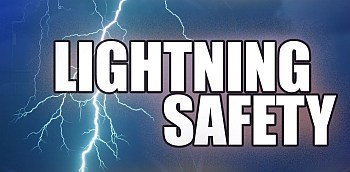June 23, 2014
 Marshall County EMA Director Clyde Avery is warning citizens of the dangers of lightning during Lightning Safety Week.
Marshall County EMA Director Clyde Avery is warning citizens of the dangers of lightning during Lightning Safety Week.
Lightning is one of the nation’s deadliest weather phenomena. Though lightning peaks in the summer, it can occur year round. According to the National Weather Service, an average of 51 people each year are killed by lightning, and hundreds more are severely injured.
To date in 2014, there have been 7 lightning fatalities.
A typical lightning flash is about 300 million Volts and about 30,000 Amps. In comparison, household current is 120 Volts and 15 Amps. There is enough energy in a typical flash of lightning to light a 100-watt incandescent light bulb for about three months or the equivalent compact fluorescent bulb for about a year.
Keep yourself and others safe by being lightning aware.
How many lightning myths have you heard?
Here are the most common MYTHS about lightning strikes and safety:
1. Golfers are most at risk of getting hit.
Not true. Among the 261 people killed by lightning between 2006 and 2013, fishermen accounted for more than three times as many fatalities as golfers — and camping and boating each chalked up almost twice as many deaths as golf.
2. If there’s lightning, lay down flat on the ground.
The truth is if you lay down on the ground, you’re more exposed to electrical currents running underground!
3. Seek Shelter Under a Tree.
Never seek shelter from lightning under a tree. It is actually the second leading cause of lightning fatalities!
4. The “30/30 rule” can keep you safe.
It’s been years since experts relied on the 30/30 rule, which went like this: If it takes less than 30 seconds to hear thunder after seeing a lightning flash, lightning is close enough to pose a threat, go indoors. And, after the storm ends, wait 30 minutes before resuming outdoor activities. Instead, the new advice is just to go inside either a substantial shelter or a hard-topped metal vehicle at the first sound of thunder. Once there, experts still recommend waiting a half-hour after you stop hearing thunder before going back outside.
5. If you’re caught outside, assume the “lightning squat.”
This is false. The idea was to squat down low with your two feet together and your hands covering your head so that your body would be tucked into a ball. The reason this doesn’t work is that people are endangered as much by ground lighting as they are by a direct strike. For instance, lightning can hit a tree and then spread along the surface of the earth. If you’re crouching on the ground, you’re likely to get hit. Again, the best advice is to head to shelter at the first sign of a storm.
6. Just go ahead with your plans during a lightning storm.
The biggest mistake most people make is not being willing to cancel or postpone activities when dangerous weather crops up. Men, who make up more than 80 percent of lightning fatalities, are notoriously unwilling to postpone a hike or head back to shore on a fishing trip. But that stubbornness may be a deadly decision.
7. Don’t touch someone who’s been struck by lightning or you’ll get shocked!
The truth is that if someone is struck by lightning; don’t be scared to assist him or her immediately. The human body does not store electricity, and helping them immediately could be essential to their survival!
Before you go out in the rain, it is crucial to know your FACTS!
1. Lightning often strikes the same place repeatedly, especially if it’s a tall, pointy, isolated object.
2. Most cars are safe from lightning, but it is the metal roof and metal sides that protect you, NOT the rubber tires.
3. A house is a safe place to be during a thunderstorm as long as you avoid anything that conducts electricity.
4. Height, pointy shape, and isolation are the dominant factors controlling where a lightning bolt will strike. The presence of metal makes absolutely no difference on where lightning strikes.
5. Is it possible to have thunder without lightning?
No, it is not possible to have thunder without lightning. Thunder is a direct result of lightning. However, it IS possible that you might see lightning and not hear the thunder because it was too far away. Sometimes this is called “heat lightning” because it occurs most often in the summer.
6. Is lightning always produced by a thunderstorm?
Yes, lightning is always produced by a thunderstorm. Lightning causes thunder, and you can’t have a thunderstorm without thunder. Thunderstorms are the only weather condition strong enough to carry water droplets to the upper parts of the atmosphere where they will freeze and become charged – because thunderstorms have an updraft.
Bottom line: Don’t take chances with lightning. The odds of being struck may be one in a million in a given year and one in 10,000 over a lifetime, but it’s better not to be that one.
For more information on lightning, visit the NOAA lightning page. And for thunderstorm safety tips visit the http://www.ready.gov/thunderstorms-lightning.
NOAA lightning page. And for thunderstorm safety tips visit the http://www.ready.gov/thunderstorms-lightning.